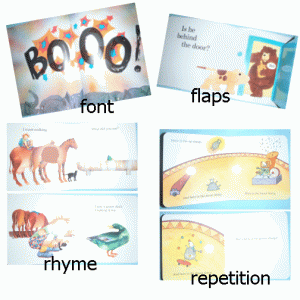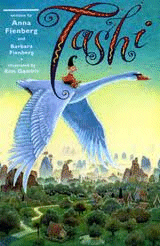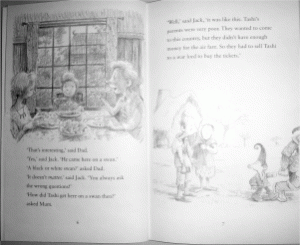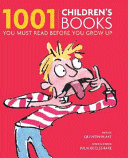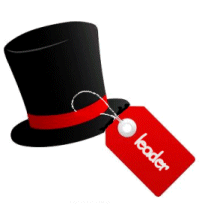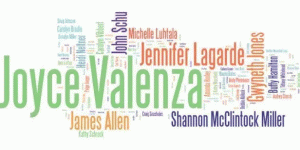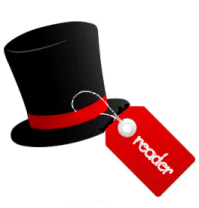
There is a perception that the role of the teacher librarian is to sit and read all day. After all, we are ‘the gatekeepers of the literature’, with the power and ability to “bring the beauty and the joy of the written word to students”.
So it comes as a surprise to many, including those who entering the profession that we are not English teachers or language arts teachers or literacy coaches on steroids. It also comes as a shock that to have any time to read anything during the day is a rare time indeed!
Nevertheless, the teacher librarian as a reader is a critical role if we are to guide students on their reading journeys, confirming their choices, consolidating their skills and helping them plan new adventures.
It is not the purpose of this post to examine the value of literature to children. Others much more knowledgeable have written about this such as Maurice Saxby’s The gift of wings: The value of literature to children. Neither is it to provide a crash course in children’s literature – there are many university courses to do that including those from Charles Sturt University. And nor is it to examine the role of literature in education – there are hundreds of pedagogical texts which address that. It’s not even to offer an opinion on what sort of literature to add to your collection and promote – your collection policy should be your guide for that. Rather, it is to consider our role as the readers’ advisory service and how we might do this better given the limited time we have.
The high purpose of book selection is to provide the right book for the right reader at the right time.
Drury, F.K.W. (1930) Book Selection Chicago: American Library Association
Every reader his or her book…
Every book its reader.
Ranganathan, S. R. (1931) The five laws of library science. Madras, India:Madras Library Association
As can be seen by the date of these two quotes, the concept of the librarian and teacher librarian as being the readers’ adviser has been around for a long time, and while it may be impossible these days to put the right book in the right reader’s hands at the right time because there are so many book and so many readers and only one of us, we do have a responsibility to have
- an understanding of the significant stages in reading development across the ages of our clientele
- an understanding of the sorts of text formats and features which support reading development at different times
- a working knowledge of those titles in the library’s collection
- a desire to continue reading the literature that is most appropriate for those in our care
Because we are teacher librarians. there is an expectation that we will have a knowledge of a child’s literacy development from the reading-like behaviour of the toddler mimicking the adult who reads to them to the independent reader who has mastered not only the mechanics but who has also taken responsibility for their “reading life” (Miller, Reading in the Wild p.xviii). Although it is not our role to be reading instructors, there is much that we can offer to support reading instruction by making selections to add to the collection that are age and stage appropriate.
In my opinion, and that of many others – experts and practitioners alike – it is not the library’s role to support instructional reading to the extent that we organise our collections according to an artificial measure such as the in-vogue assignment of a lexile which does not take into account the prior knowledge or maturity level required to enjoy the book to its fullest, or according to a points system imposed by a commercial scheme or any other arbitrary standard that is likely to limit or marginalise our students based on their choices. However, we do have a responsibility to provide titles which have the textual and graphical formats and features that support the students at different times in their reading lives.
We need to know that
- role play readers display reading-like behaviour which imitates those who read to them as they reconstruct the story for themselves, often differently each time as they use the pictures to prompt their memories. They need durable books with bright pictures that have recognisable elements and have text which incorporates rhyme, rhythm and repetition so they can join in as it is read or repeat it as they retell it.
- experimental readers rely on their memory of familiar stories to retell them and the retelling is close to the original story as they understand that text carries a constant meaning. They rely on pictures to prompt their recall and may recognise familiar words so they need books with limited text where key words are often enlarged or in a different font; have repetitive phrases either cumulative or alliterative which they can memorise and repeat; and pictures which are lifelike and may have fun elements such as lift-the-flap. They also like stories featuring familiar characters from their favourite television series as they bring their knowledge of the situation and the character to an unfamiliar situation.
- early readers read texts slowly and deliberately, concentrating on every word and using their knowledge of the context and pictorial clues to support their meaning-making and their retelling. They are ready for new characters in new situations although they like these to mirror their own experiences and issues. Animals and toys in human-like dilemmas allow them to discuss and reflect on their own situations, setting up the foundation for the development of critical literacy skills. They prefer their stories to be completed in one sitting although many will listen to serialised stories where there is a complete adventure in each chapter such as The Faraway Tree series by Enid Blyton.
- transitional readers are able to use a variety of strategies to make meaning from texts and adapt their reading to different types of text. They understand the basics of story construction such as setting, plot and characterisation and are beginning to think critically about texts. They are making the transition from basal readers and picture books to novels which have short chapters, larger fonts and monochrome illustrations which still support the storyline. They’re willing to move beyond settings and characters with which they are familiar and into the realms of the imaginary and the fantastic. Series are popular and they are beginning to identify favourite authors and topics.
- independent readers are just that. They can read, retell and reflect on texts choosing from a wide range of authors, series, subjects and genres. They have favourites and can justify their choices, and select according to need, interest and mood. They have developed the emotional connections that lifelong readers possess and share an innate love of reading.
Adapted from Reading Developmental Continnuum. Education Department of Western Australia, 1994
Even if our clientele do not span the range of readers, we should know where they have come from and to where they are headed.
Miller tells us
The path to lifelong reading habits depends on internalising a reading lifestyle along with reading skills and strategies.
And she also says
We must push ourselves to read widely in order to best serve our students – as role models who read for diverse purposes and reading advisers who know a lot about books that appeal to all types of readers. The more widely we read, the more expterise we offer to our students.
This is where we must put on the reader’s hat. If we are to help our students along their road to independence then we must read and read and read so we can assist them with their choices, and assist their teachers in their choices. It may be that during term time your pile of to-be-read books comprises only children’s literature but it will pay off because not only will the staff and students view you as the go-to person when they’re wondering what to read next, but it puts the library at the hub of the school’s literacy program known for a collection that is built on professional knowledge and tested against a set of selection criteria that ensures it meets certain standards.
Just as we should not let personal bias interfere with the selection of resources for the collection, so we should not let personal preferences dictate our reading selections. Of course, as we first start to learn about the collection from the inside out, we will start with our favourite authors, topics, series and genres but we need to read beyond those boundaries so we can build a broad base of knowledge and understanding.
Many of us will have childhood favourites or those we have used in our classroom practice and which we know children enjoy and it’s worth finding these and re-reading them as a starting point. Then start to branch out. There are many sources…
- Publishers have regular free newsletters that you can subscribe to so you can keep up-to-date with new releases. As well as Australian publishing houses, I also subscribe to some in the US and UK which is how I had copies of Harry Potter and the Philosopher’s Stone on the shelves when students came in demanding it.
- Use subscription services which provide reviews and overviews from a wide range of publishers. I like Publisher’s Weekly which has a range of free e-newsletters including Children’s Bookshelf which has a plethora of articles related to children’s literature including reviews, meet-the-author, podcasts and news but others include Booklist, Horn Book, School Library Journal, Scan, and Magpies which includes The Source and The Literature Base.
- Look at the publishers’ catalogues and websites, particularly those of the independents who often publish new authors or books with interesting topics. If you’re going to a conference or network meeting, browse the vendor displays – and perhaps pick up a bargain!
- Learn which newspapers and periodicals promote books for your target clientele and follow their reviews and recommendations.
- Know your students’ favourite authors as well as those who write for your students’ age group and keep tabs on their websites and blogs. There are often sneak previews, sample chapters, book trailers, information about public appearances and what they’re currently working on so you can look for them in the future.
- Look for new authors whose work might appeal to your students by becoming familiar with the independent publishers as well as the mainstream ones. Find the CBCA page on Facebook where new authors often let others know of their work, including that which has been self-published.
- Browse the bookstore displays to see what’s new and recommended in a variety of genres. Some bookstores promote staff recommendations so you can discuss possibilities with them.
- check out second-hand stores for older titles that may no longer be in print but which are still popular
- Look at what other TLs are posting on their library blogs and websites to discover what other students are reading
- Seek out blogs which review the titles for your target age group. There are many of these, particularly for YA, and I’ve gathered some of them on Blogs About Books. Three that are great for younger readers are A Book and a Hug (have your readers take the What kind of reading superhero are you? quiz to find out what they might like); The Book Chook which has a strong Australian flavour and The Bottom Shelf where I review picture books, old and new, for the under-8s. Create your own blog where you share your reading with others.
- Read reviews. There are many sites and journals which are dedicated to reviewing children’s literature and I’ve collated some of these on the Read a Review page.
- Get recommendations from other teachers and teacher librarians using your personal learning networks such as OZTL_NET. Everyone has a favourite they like to share. If schools have organised book clubs, find out what books they are focusing on.
- Use crowd-sourcing sites such as Goodreads and Shelfari where you can get recommendations as well as creating your own reading journal. Follow dedicated pages on Facebook and Twitter.
- Talk to the students about what they are reading. Miss 9, an avid reader, told me that the favourite story among her peers this year was the classic Black Beauty and she was delighted when she found a copy of it among a collection of other classics on my home shelves. She’s now reading her way through them, as well as War Horse by Michael Morpurgo which is of a similar nature to Black Beauty. One conversation and she had two pathways to follow – the classics, which may well open up new paths in themselves, and the other works of Morpurgo.
- Ask the students what they think you should be reading. Many will have favourites that they have sourced beyond the school library and which you need to know about and consider for the collection. Peer recommendations are powerful, as even the most reluctant reader wants to be part of the in-crowd.
- Keep abreast of new and upcoming releases through sites such as
- Troll the best-of lists that come out at the end of the year from a range of sources. It’s surprising how many titles are common entries on these lists, indicating that they are worth considering. If you want to discover the best of the best of times gone by, look for publications such as 1001 Children’s Books you must read before you grow up
- Look at the award winners such as the Australian Children’s Book of the Year, the Newbery Medal, the Caldecott Medal, The Kate Greenaway Medal and The Carnegie Medal
- Look for and explore “if-you-like-x-then-try… lists. They are a great source of new titles that match an identified preference.
- Know which books have been turned into movies, or are about to be, and read the print versions of them so both you and your students are familiar with them, but be aware that the movie’s rating may be different to that of the book. Useful sites are…
- Trust your experience and expertise – if you see a book that you think will appeal, read it.
- If you want to try before you buy, check out what your public library has. Build a relationship with your local children’s services librarian and discover what are the most commonly borrowed titles there.
- Maintain your professional reading with books like The Book Whisperer, Reading in the Wild, Readicide, The Rights of the Reader, The Power of Reading, The Read-Aloud Handbook and Igniting a Passion for Reading. Each will help you understand how to wear your reader’s hat well.
Wear your reader’s hat in public. Let the children see you reading in those rare spare minutes that you get. Let them see your pile of to-be-reads. Let them see the reading goals you have set yourself and which you celebrate as you achieve them. Let them flip through your reading journal where you keep an annotated record of what you’ve read, what you want to read and their recommendations.
If you put your reader’s hat on, they will too.

